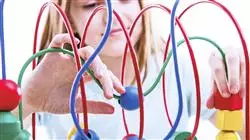University certificate
The world's largest faculty of education”
Introduction to the Program
Become an expert in Child and Adolescent Psychopathology with TECH and help your students with difficulties to develop academically in a satisfactory way”

The different pedagogical methodologies that have been described based on the exhaustive study of the different psychopathologies that can occur in the infant or young person have allowed the development of academic strategies adjusted to the specifics of each case, giving these students the opportunity to continue to evolve in an adapted manner during the school stage. However, in order to make this adaptation, it is necessary for the teacher to know in detail the characteristics of the different pathological universes that can occur in children and adolescents.
For this purpose, TECH Global University has launched this very complete Postgraduate diploma in Child and Adolescent Psychopathology, a program oriented to teachers, directed and designed by experts, as well as presented in a convenient and accessible 100% online format. This is a multidisciplinary degree through which the graduate will be able to delve into the disorders, issues, and conditions of neurodevelopment, as well as the associated problems that may arise from suffering from them: anger, aggressiveness, addictions, etc.
Therefore, it is a unique opportunity to broaden your knowledge and perfect your teaching skills through a degree adapted to the academic and professional market demands. In addition, all the content will be available from the beginning of the academic activity and can be downloaded to any device with an Internet connection, whether mobile, tablet, or computer. Therefore, the graduate will be able to study for this Postgraduate diploma from wherever they want and with a schedule totally adapted to their availability.
You will work on the different psychopathological universes that can occur in the child and adolescent student through an exhaustive and dynamic syllabus”
This Postgraduate diploma in Child and Adolescent Psychopathology contains the most complete and up-to-date educational program on the market. The most important features include:
- The development of case studies presented by experts in psychology and education
- The graphic, schematic, and practical contents with which they are created, provide scientific and practical information on the disciplines that are essential for professional practice
- Practical exercises where self-assessment can be used to improve learning
- Its special emphasis on innovative methodologies
- Theoretical lessons, questions to the expert, debate forums on controversial topics, and individual reflection assignments
- Content that is accessible from any fixed or portable device with an Internet connection
You will have access to 600 hours of the best theoretical, practical, and additional content so that you will obtain the most complete and exhaustive knowledge from this Postgraduate diploma”
The program’s teaching staff includes professionals from the sector who contribute their work experience to this educational program, as well as renowned specialists from leading societies and prestigious universities.
Its multimedia content, developed with the latest educational technology, will provide the professional with situated and contextual learning, i.e., a simulated environment that will provide an immersive education programmed to learn in real situations.
This program is designed around Problem-Based Learning, whereby professionals must try to solve the different professional practice situations that arise throughout the program. For this purpose, the student will be assisted by an innovative interactive video system created by renowned experts.
Knowing in detail the circumstances related to suicide in childhood and adolescence will allow you to become an agent in its prevention"

A perfect program to delve into substance and non-substance addiction problems so you can help your students overcome them"
Syllabus
The graduate who accesses this degree will find 600 hours of the best theoretical content prepared by the teaching body based on the immediate current situation of the educational sector and Psychology. It also includes high-quality additional material presented in different formats (detailed videos, dynamic summaries, case studies, complementary readings, and research articles), thanks to which you will be able to contextualize the information developed in the syllabus and delve into the aspects you consider most important. All this in a convenient and accessible 100% online program compatible with any device with an Internet connection.

You will have at your disposal real cases of students with different Psychopathologies so that you can put your skills into practice and adapt the academic curriculum to their specifications and needs”
Module 1. Pathological Universes in Childhood and Adolescence
1.1. Neurodevelopment Disorders
1.1.1. What are Neurodevelopmental Disorders?
1.1.2. Disorders Included in the Diagnostic Category of Neurodevelopmental Disorders
1.1.3. Relevant Aspects of Neurodevelopmental Disorders in Childhood and Adolescence
1.2. Schizophrenia Spectrum Disorders and Other Psychotic Disorders
1.2.1. What are Schizophrenia Spectrum Disorders and other Psychotic Disorders?
1.2.2. Disorders Included in the Diagnostic Category of Schizophrenia Spectrum Disorders and Other Psychotic Disorders”
1.2.3. Childhood Schizophrenia
1.3. Bipolar and Related Disorders
1.3.1. What are Bipolar and Related Disorders?
1.3.2. Disorders Included in the Diagnostic Category of Bipolar and Related Disorders”
1.4. Depressive Disorders
1.4.1. The Universe of Depressive Disorders
1.4.2. Disorders Included in the Diagnostic Category “Depressive Disorders”
1.5. Anxiety Disorders
1.5.1. Anxiety Disorders
1.5.2. Types of Anxiety Disorders included in the DSM-V
1.5.3. Relevance of Anxiety Disorders in Childhood and Adolescence
1.6. Obsessive Compulsive Disorder and Related Disorders
1.6.1. Introduction to Obsessive-Compulsive Disorder and Related Disorders
1.6.2. Disorders Included in the Diagnostic Category of Obsessive-Compulsive Disorder and Related Disorders”
1.7. Trauma and Stress-Related Disorders
1.7.1. What are Trauma-Related Disorders and Stressors?
1.7.2. Disorders Included in the Diagnostic Category of “Disorders Related to Trauma and Stressors”
1.8. Dissociative Disorders
1.8.1. Characteristics of Dissociative Disorders
1.8.2. Disorders Included in the Diagnostic Category of “Dissociative Disorders”
1.9. Somatic Symptom Disorders and Related Disorders
1.9.1. What are Somatic Symptom Disorders and Related Disorders?
1.9.2. Disorders included in the Diagnostic Category of “Somatic Symptom Disorders and Related Disorders”
1.9.3. Evidence and Data of Relevance on Factitious Disorder as Applied to Another (in Children and Adolescents)
1.10. Eating and Food Ingestion Disorders
1.10.1. What are Eating and Food Intake Disorders?
1.10.2. Eating and Food Intake Disorders included in the DSM-V
1.10.3. Relevant Data on Eating and Food Intake Disorders in Adolescence
Module 2. Pathological Universes in Childhood and Adolescence II
2.1. Excretory Disorders
2.1.1. What is called “Excretion Disorders”?
2.1.2. Types of Excretion Disorders
2.2. Sleep-Wake Disorders
2.2.1. Common Characteristics of Sleep-Wake Disorders
2.2.2. Disorders Sleep-Wake Disorders Included in the Diagnostic Category“ Sleep-Wake Disorders”
2.3. Gender Dysphoria
2.3.1. Gender Dysphoria
2.3.2. Relevant Situations of the Gender Factor in the Childhood and Adolescence
2.3.3. How Today’s Children Experience Sexual Problems?
2.4. Disruptive, Impulse-Control and Behavioral Disorders
2.4.1. Types of Disruptive, Impulse-Control and Behavioral Disorders
2.4.2. Common Problems Fear-Related with Behavioral Management of Infants in Psychological Therapy
2.5. Substance Abuse and Addictive Disorders
2.5.1. What are the Disorders Related to Substance Abuse and Addictive Disorders?
2.5.2. Disorders Included in the Diagnostic Category of “Disorders Related to Substances and Addictive Disorders”
2.6. General Personality Disorder
2.6.1. Personality Theories
2.6.2. General Personality Disorder According to DSM-V
2.7. Paraphilic Disorders
2.7.1. Paraphilic Disorders
2.7.2. Incidence of Paraphilic Disorders in Childhood and Adolescence
2.8. Other Problems that can be Targeted Clinical Care
2.8.1. Parent-child relationship problem and sibling relationship problem
2.8.2. Child Abuse and Neglect. Sexual Abuse
Module 3. Personality Disorders in Childhood and Adolescence
3.1. Paranoid Personality Disorder
3.1.1. Introduction to Paranoid Personality Disorder
3.1.2. Diagnostic Criteria
3.1.3. Paranoid Personality in Childhood
3.2. Schizoid Personality Disorder
3.2.1. Introduction to Schizoid Personality Disorder
3.2.2. Diagnostic Criteria
3.2.3. Schizoid Personality in Childhood and Adolescence
3.3. Schizotypal Personality Disorder
3.3.1. Introduction to Schizotypal Personality Disorder
3.3.2. Diagnostic Criteria
3.3.3. Schizotypal Personality in Minors How It Differs from Adult Neuropathology
3.4. Borderline Personality Disorder
3.4.1. Introduction to Borderline Personality Disorder
3.4.2. Diagnostic Criteria
3.4.3. Borderline Personality in Childhood and Adolescents
3.5. Narcissistic Personality Disorder
3.5.1. Introduction to Narcissistic Personality Disorder
3.5.2. Diagnostic Criteria
3.5.3. Narcissist Personality in Children
3.6. Antisocial Personality Disorder
3.6.1. Introduction to Antisocial Personality Disorder
3.6.2. Diagnostic Criteria
3.6.3. Antisocial Personality in Minors
3.7. Histrionic Personality Disorder
3.7.1. Introduction to Histrionic Personality Disorder
3.7.2. Diagnostic Criteria
3.7.3. Histrionic Personality in Childhood and Adolescence
3.8. Avoidant Personality Disorder
3.8.1. Introduction to Avoidant Personality
3.8.2. Diagnostic Criteria
3.8.3. Avoidant Personality and its Relation to Childhood and Adolescence Stage
3.9. Dependent Personality Disorder
3.9.1. Introduction to Dependent Personality
3.9.2. Diagnostic Criteria
3.9.3. Avoidant Personality and its Relation to Childhood and Adolescence Stage
3.9.4. Implications of the Dependent Personality in Adulthood
3.10. Obsessive-Compulsive Personality Disorder
3.10.1. Introduction to the Concept of Obsessions and Compulsions
3.10.2. Concept of Compulsive Personality Disorder and Diagnostic Criteria
3.10.3. Obsessive-Compulsive Personality in Childhood
Module 4. Others Related Problems
4.1. Anger and Aggressiveness Problems
4.1.1. Introduction to Anger and Aggressiveness Problems
4.1.2. Anger and Aggressiveness Problems in the Psychological Consultation
4.2. Substance Addiction Problems
4.2.1. Introduction to Substance Addiction
4.2.2. The problems of Substance Abuse in MInors
4.2.3. Substance Abuse Fads in Minors
4.3. Substance Addiction Problems(TIC)
4.3.1. Introduction to ICTs
4.3.2. Addiction to ICTs in Minors
4.4. Problems Derived from ICT
4.4.1. Major Problems Derived from ICT
4.5. Emotional Problems in Childhood and Adolescence
4.5.1. Introduction to Emotions
4.5.2. Emotions in Childhood and Adolescence
4.5.3. Major Emotional Problems in Childhood and Adolescence
4.6. Self-Esteem and Self-Concept Problems
4.6.1. Introduction to the Concept of Self-Esteem and Self-Concept
4.6.2. Major Self-Esteem and Self-Concept Problems
4.7. Suicide in Childhood and Adolescence
4.7.1. Introduction to Suicide
4.7.2. Suicides in the Childhood and Adolescence Stage
4.8. Characteristics of Oppositional Defiant in Children and Adolescents
4.8.1. Introduction to Oppositional Defiant Disorder
4.8.2. Major Characteristics of Oppositional Defiant in Children and Adolescents
4.8.3. Major Characteristics of Oppositional Defiant in Adolescents
4.9. The Most Common Neurodevelopment Conditions
4.9.1. Introduction the Neurodevelopment Conditions
4.9.2. Neurodevelopment Conditions in Minors

Do not think twice and invest in a qualification with you will not only become a more prepared professional but with which you will be able to give another opportunity to your students with special needs”
Postgraduate Diploma in Child and Adolescent Psychopathology
Did you know that child and adolescent psychopathology recognizes that children and adolescents may not only experience emotional and behavioral difficulties, but may also exhibit symptoms and mental disorders that are different from those seen in adults? These disorders can manifest themselves in a variety of areas such as behavior, mood, thinking and social relationships. Given this scenario, it is important that psychologists specialize in this field, in order to adequately treat such conditions. Under this premise, TECH Global University presents its Postgraduate Certificate in Child and Adolescent Psychopathology, a detailed look at the multiplicity of schemes that take place in this health field. Here, we propose an entirely online journey through various modules ranging from the theoretical and practical bases of psychopathology, to the most common disorders and problems affecting children and adolescents. In addition, we will address the stages of development and the risk and protective factors that can influence mental health in this population.
Be an expert in child and adolescent psychopathology
At TECH we provide you with a comprehensive curriculum, designed by specialists, through which you will explore topics such as autism spectrum disorders, anxiety, mood and behavioral disorders. Likewise, you will learn to identify and evaluate symptoms, as well as design and implement effective interventions. Finally, you will address different therapeutic approaches and intervention models used in the field of child and adolescent psychopathology. This will allow you to focus on best practices in the treatment of disorders, taking into account scientific evidence and professional ethics. Upon completion of the program, you will be equipped with the tools necessary to understand, assess and intervene in cases of child and adolescent psychopathology. You will gain a solid knowledge of the most frequent disorders and will be prepared to collaborate in multidisciplinary teams to improve the quality of life of children and adolescents facing psychological difficulties.







